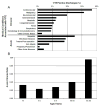Pediatric venous thromboembolism in the United States: a tertiary care complication of chronic diseases
- PMID: 22038730
- PMCID: PMC3270120
- DOI: 10.1002/pbc.23388
Pediatric venous thromboembolism in the United States: a tertiary care complication of chronic diseases
Abstract
Background: Pediatric venous thromboembolism (VTE) is an increasingly common problem. We hypothesized that VTE occurs most commonly in tertiary care settings and that the pattern of associated illnesses may have changed from earlier reports.
Methods: The Kids' Inpatient Database 2006 was utilized to identify children ≤ 18 years old with in-hospital VTE. Children were identified by the presence of thrombosis specific ICD-9-CM diagnosis or procedure codes. Remaining ICD-9-CM codes were utilized to categorize patients by acute or chronic illness. The incidence of in-hospital VTE by hospital type, age, gender, race, and disposition were estimated.
Results: Over 4,500 children met the inclusion criteria (188/100,000 discharges). Most VTE discharges (67.5%) were from children's hospitals (RR 5.09; 95% CI 4.76; 5.44). Underlying chronic illnesses were associated with most VTE (76.2%), most commonly: cardiovascular (18.4%), malignancy (15.7%), and neuromuscular disease (9.9%). VTE not associated with chronic illness were most often idiopathic (12.6%), followed by infections (9.5%), and trauma (9.1%). The greatest proportions of children with VTE were infants (23.1%) and adolescents (37.8%). However, when standardized against the entire database of discharges, infants were least likely to develop VTE (RR 0.48; 95% CI 0.43; 0.52), while adolescents were at highest risk (RR 1.89; 95% CI 1.73; 2.07). Hospitalizations ending with death were more likely to include VTE (RR 6.16; 95% CI 5.32; 7.13).
Conclusions: Pediatric VTE is most commonly seen in tertiary care. Adolescents are at greatest risk to develop in-hospital VTE. Patients whose hospitalization ended with death are at much greater risk to develop VTE.
Copyright © 2011 Wiley Periodicals, Inc.
Conflict of interest statement
Figures



References
-
- Andrew M, David M, Adams M, et al. Venous thromboembolic complications (VTE) in children: first analyses of the Canadian Registry of VTE. Blood. 1994;83(5):1251–1257. - PubMed
-
- Raffini L, Huang YS, Witmer C, et al. Dramatic increase in venous thromboembolism in children’s hospitals in the United States from 2001 to 2007. Pediatrics. 2009;124(4):1001–1008. - PubMed
-
- Vu LT, Nobuhara KK, Lee H, et al. Determination of risk factors for deep venous thrombosis in hospitalized children. J Pediatr Surg. 2008;43(6):1095–1099. - PubMed
-
- Bajzar L, Chan AK, Massicotte MP, et al. Thrombosis in children with malignancy. Curr Opin Pediatr. 2006;18(1):1–9. - PubMed
-
- David M, Andrew M. Venous thromboembolic complications in children. J Pediatr. 1993;123(3):337–346. - PubMed
Publication types
MeSH terms
Grants and funding
LinkOut - more resources
Full Text Sources
Miscellaneous

